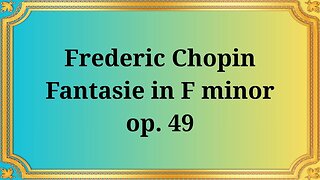Premium Only Content

Ludwig van Beethoven Sonata In F Major For French Horn And Piano, Op 17
#Beethoven #SonataInFMajor #FrenchHorn #Piano #Opus17 #ClassicalMusic #MusicalComposition
Sonata in F Major for French Horn and Piano, Op. 17
Gerd Seifert, French Horn Martin Galling, Piano
Ludwig van Beethoven, a towering figure in the world of classical music, crafted numerous masterpieces that continue to resonate with audiences today. Among his extensive body of work, the Sonata in F Major for French Horn and Piano, Opus 17, stands as a testament to Beethoven's innovative approach to composition.
The Sonata in F Major was composed by Beethoven in 1800, during the transition between the classical and romantic periods of music. This period was marked by a shift towards emotional expression and individualism in composition. Beethoven, known for pushing boundaries, embraced this transition in his works, paving the way for the Romantic era that followed.
The Sonata in F Major is organized in four distinct movements: Allegro moderato, Poco adagio, Rondo: Allegro moderato, and Allegro moderato. This structure follows the traditional sonata form, with each movement contributing to the overall narrative of the piece. Beethoven's meticulous attention to form ensures a cohesive musical journey for both the performers and the listeners.
One of the most captivating aspects of this sonata is its ability to convey a wide range of emotions. In the first movement, the Allegro moderato, the French horn introduces a lyrical and expressive theme, which is then echoed by the piano. The Poco adagio movement reveals a more introspective and melancholic mood, allowing the performers to explore the depths of their instruments' capabilities. The Rondo: Allegro moderato movement brings a sense of playfulness and joy, while the final Allegro moderato movement showcases virtuosic passages and a triumphant conclusion.
The Sonata in F Major highlights the unique partnership between the French horn and piano. Beethoven skillfully balances the melodic lines and harmonies between the two instruments, creating a dialogue that is both complementary and contrasting. The French horn, with its warm and rich tonal quality, takes center stage in many sections, while the piano provides a supportive and dynamic accompaniment. The collaboration between these instruments gives the sonata a distinct character and allows for a captivating musical conversation.
Beethoven's Sonata in F Major for French Horn and Piano, Opus 17, remains a cherished piece in the repertoire of both performers and listeners. Its combination of technical challenges, expressive depth, and the inherent beauty of the French horn and piano creates a unique and captivating musical experience. This composition showcases Beethoven's ability to push the boundaries of traditional forms while maintaining a sense of balance and emotional resonance.
Conclusion:
Ludwig van Beethoven's Sonata in F Major for French Horn and Piano, Opus 17, stands as a testament to the composer's genius and innovation. Through its structure, expressive qualities, and the delicate interplay between the French horn and piano, this musical work continues to captivate audiences with its beauty and emotional depth. As we listen to this sonata, we are reminded of Beethoven's lasting impact on the world of classical music and his ability to create timeless compositions that resonate with generations.
You have the opportunity to support the channel:
https://destream.net/live/RadSiarAl/donate
https://www.buymeacoffee.com/6355radsiaral
-
 11:13
11:13
Classical music_Music Inspiration
1 day agoFrederic Chopin Fantasy in F minor, Op. 49
282 -
 LIVE
LIVE
The Bubba Army
21 hours agoFeds STEP IN on Charlotte Stabbing Case - Bubba the Love Sponge® Show | 9/10/25
4,764 watching -
 LIVE
LIVE
FyrBorne
10 hours ago🔴Warzone M&K Sniping: An Old Meta Returns To Cut Down The Competition
55 watching -
 25:54
25:54
ZeeeMedia
13 hours agoThe Shadow Government, Mask Plague, Nepal Uprising Topples Government | Daily Pulse Ep 104
6.23K23 -
 LIVE
LIVE
Biscotti-B23
6 hours ago🔴 LIVE DRAGON BALL GEKISHIN SQUADRA IS HERE 🐉 RANKED MATCHES & BATTLE PASS SHOWCASE
18 watching -
 27:40
27:40
TheRoyaltyAutoService
14 hours ago $0.61 earnedHow To Replace A Battery Like A Professional!
17.1K1 -
 5:15:03
5:15:03
B2ZGaming
5 hours agoTwo For Tuesday!!! | B2Z Gaming
142 -
 LIVE
LIVE
BBQPenguin_
3 hours agoExtraction Action! Looting & PVP
11 watching -
 8:52
8:52
The Art of Improvement
20 hours ago $0.16 earned7 Habits Of Unsuccessful People You Don’t Want To Copy
1.31K -
 36:17
36:17
Uncommon Sense In Current Times
16 hours ago $0.52 earnedIs Humanism A Religion in Disguise: A Discussion with Humanist Stephen Law - Part 1
8.57K2